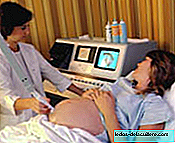
One issue that parents are very concerned about when they are waiting for a baby, of course, is to make sure that they are healthy and that they do not suffer from any disease or deformity.
Today there is diagnostic methods very effective that, according to the specialists responsible for the Fetal Medicine Unit of the San Francisco Javier de Bilbao Hospital, allow to detect 90% of the malformations of the fetus.
Through ultrasound and diagnostic tests such as ERAC (Risk Estimation of Chromosomal Abnormalities or triple screening), the most common fetal pathologies such as Down syndrome, spina bifida, fetal heart disease or diaphragm hernias can be identified.
According to doctors, using non-invasive systems such as an ultrasound during the first trimester and a biochemical blood test between weeks 11 and 14, 90% of chromosomal abnormalities can be detected.
While with general measures such as practicing amniocentesis to all women over 35 years of age, only 23-30% of cases are detected.
Therefore, they suggest leaving amniocentesis for cases in which biochemical analyzes indicate a high risk, which should be clarified that it is a risk estimation index and not a diagnostic method.
It means that even if the risk is high, it does not mean that the baby has a defect. In that case, only amniocentesis or corial biopsy can determine it.
They also suggest invasive prenatal diagnostic tests for cases in which there is a history of congenital defects or repeated abortions or in which ultrasound reveals a physical fetal malformation.
In all cases, the anguish that we parents experience with the possibility that our baby has a serious defect is inexplicable.
Therefore, beyond statistics and generalities, I believe that each particular case should be treated by exhausting all the necessary tests that determine the state of the baby.












